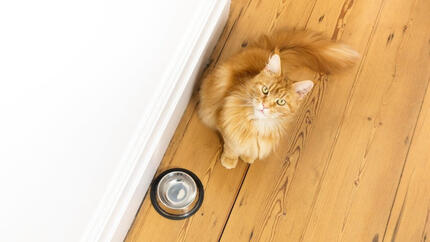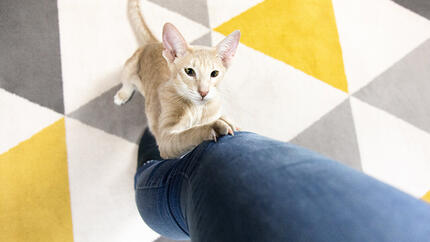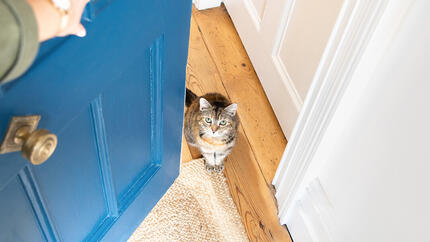

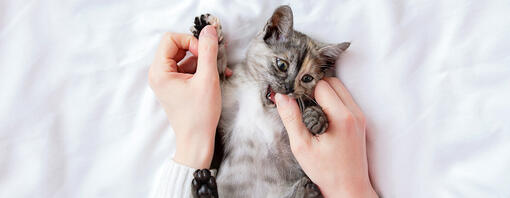
It's not pleasant if you have a cat who often seems to bite you. Learn more about the reasons why cats bite and the best ways to stop it with our guide and tips.
It’s not uncommon for cats to bite. There are many reasons as to why a cat might suddenly start biting, seemingly unprovoked. It’s important to understand that cat-biting is rarely done out of aggression, and if it is, it doesn’t mean your cat is ‘bad’.
Cats are natural born predators, and as such seemingly aggressive actions such as biting, pouncing and clawing make up a large part of their play. Allowing and encouraging an outlet for this natural instinct is important for felines, but there is a fine line between engaging in stimulating play and encouraging or even causing aggressive behaviour.
Learn more about the reasons behind why cats bite in order to help to stop any unnecessary biting.
Why do cats bite?
Cats bite for a variety of reasons – this can be because they are scared, maybe trying to avoid an experience they dislike such as over-handling or being held, or have learnt or have been taught that predatory play is enjoyable.
Other reasons for biting or apparent aggression may be that they are not getting an outlet for their natural need to indulge in predatory behaviours – and some breeds, types or individuals need this more than others. They may also bite to seek attention.
Biting often happens because a cat’s interaction style is often totally at odds with our interaction style. Cats tend to like short, low key interactions whereas humans like prolonged interactions which for cats can just be way too intense.
Whatever the specific reason, a cat that starts biting is trying to tell you something – it may be about themselves, about their environment, or about your behaviour towards them. It’s important to listen and attempt to understand what your cat is trying to communicate.
Why does my cat bite me when being petted?
One of the most common complaints from cat owners is the sudden change in attitude that can occur during petting: one second a cat may be loving the attention, the next they’re biting your fingers or the claws come out!
If you know what to look out for, it’s easy to tell when a cat has had enough of stroking, but learning to read your cat’s body language will help you to know when a bite might be coming.
Cats will often come to you for attention but what they usually want is a short burst of gentle stroking on the part of the body they enjoy. Or they just want to enjoy your proximity and company, and don’t really want to be touched. Most cats – and there are always exceptions - don’t want prolonged interactions, or interactions that involve holding or cuddling.
When your cat bites in this situation they are telling you they’ve had enough. While an owner may think a bite has come from nowhere, for a cat things have just got too intense and in their mind, the action is entirely justified.
Let all interactions be your cat’s idea, and every 10 seconds or so, stop and see if they nudge at your hand or indicate they want you to continue. If not, stop stroking them, let them leave if they want to, or just let them hang out quietly with you.
Why does my cat bite me when playing?
Cats often bite during play because they are expressing their natural hunting instinct.
For kittens, biting and bunny-kicking are normal play behaviours. They play like this with their littermates and mothers and it mimics how they pounce, grab and bite their prey.
Cats only have one way to play – and that is using their teeth and claws. The important thing is that you don’t play with your cat or kitten using your hands. Hands are for stroking and scratching. Use toys (such as toys on strings or any of the fun interactive chase toys you can buy – or just scrunched up paper etc) to encourage cat-specific play and give them an outlet for that hunt, chase, pounce, bite behaviour that cats need to keep them healthy and happy.
You can discourage biting behaviour by praising them for not biting bonding sessions and by quietly disengaging from play that gets too rough or toothy.
Whenever your cat engages in play with you that uses their paws, but not their claws or teeth, reward them with a favourite treat.
Cat love bite
This form of cat biting can occur when they are being petted and have had enough, or similarly during play. It is usually the result of overstimulation or an indication that they have withdrawn their consent to be touched and we should listen.
Aggressive cat biting
Although most cat biting will often just be a warning nip or over-excited play, it can sometimes become an expression of aggression. Biting during play is fairly easy to distinguish from aggressive behaviour: these little nips won’t cause much damage, and are over quickly. Aggressive cat biting should be taken seriously straight away.
This means identifying whether the behaviour is a result of fear, pain, illness or inappropriate predatory behaviour.
If biting occurs when you initiate interaction with your cat, for example, you pick them up, cuddle them, stroke them or go to groom, bathe or put them in a cat carrier, it is likely your cat is attempting to stop the interaction. Sometimes we do need to do things with our cats that they won’t automatically like, and training to desensitise and pair these experiences with nice things such as tasty food rewards can help here.
Sudden aggression in situations where your cat does not usually bite can be indicative of pain. A visit to the vet to rule out any clinical causes, or treat them, is important as a first step, rather than a last resort. While you are working to identify the problem, avoid doing the things that trigger aggressive behaviour in your cat because that is likely to either be causing pain or else the fear of pain.
Predatory play is another matter, some cats (often depending on their breed/type) enjoy vigorous and athletic predatory play. These cats need plenty of daily enrichment with opportunities to climb, hunt, chase, pounce and bite. They can be a joy to own but they are high maintenance! Without this outlet, they can start to show aggressive behaviour towards their families in their boredom and frustration.
Prevent anyone from encouraging such play – for example, people using their hands instead of toys, provoking or teasing the cat.
Provide cat trees, platforms and a variety of toys, ideally some that will dispense food, to fulfil their desire without biting, grabbing or jumping on humans.
If your cat does attempt to leap on you or hurt you, move slowly, stay quiet and disengage calmly. Fast movements, shouting or physical contact with the cat will only make matters worse. Avoid giving your cat access to people who can’t respond in this way or who can be seriously hurt, for example very elderly visitors or small children.
Why does my cat bite me and no one else?
There are various reasons for this, and it all has to do with the purpose of the biting behaviour and your history with your cat. If the response is one of fear, it can be that your cat is scared and if they don’t have the opportunity to get away, the cat may bite as an outcome of this. If you play with them using your hands, you may well have taught them to bite. Or it may be that because you are the one who loves them, you want to shower them with more affection than they are comfortable with.
How will I know if my cat is about to bite me?
When it comes to cat biting, quite often, you will be able to notice whether a cat is about to bite or not by looking at their body language. Here are a few things to look out for:
- A cat who has been purring, stopping purring.
- Stopping the interaction with you.
- Tensing their body or even briefly freezing.
- Flicking their tail.
- Raising their paw.
- Looking at you and wiggling their bottom.
- Claws may come out.
- Ears may flatten.
- Hissing, spitting, low growls (not purrs).
- They are looking at your hand, feet or arms.
- Whiskers moving forwards.
- And of course if you are in tune with your cat, you just ‘know it’!
How to stop your cat from biting you
You can help them to exercise this natural instinct by providing toys that they can bite and claw to their heart’s delight, which then gives them an outlet for this behaviour and distracts them from your limbs.
There are a few different approaches to stopping cat biting but never shout or push your cat away. It is always best to remain calm, a few other ways to stop your cat from biting you are:
- Play with your cat with appropriate toys as much as you can. The more appropriate enrichment they get, the more you will reduce any predatory behaviours directed towards you!
- Meet your cat’s needs for exercise and play before they feel the need to demand your attention. Pre-empt their desire to play by providing a variety of cat toys, platforms, trees etc.
- Make sure they feel safe, secure and not stressed in any way. Ensure they have free access to the outdoors or else to litter trays if they are indoor cats, food, water, places to hide, climbing opportunities etc.
- Don’t startle your cat and handle your cat gently when picking them up or petting them. Don’t ever be too rough with them as this can encourage biting behaviours.
- When you first bring a kitten or new cat home with you, give them time to settle in and trust you.
- If their biting behaviours have suddenly becoming worse, then seek medical advice from your vet or if you are worried they are becoming aggressive, seek advice from a behaviourist.
Kitten biting phase
Don’t be concerned when your kitten starts biting and pouncing during play with you – or even with other animals in the household.
For all cats, the act of play fighting makes up a huge amount of their play. They enact these tendencies as a natural instinct: practising for the day when they will need to hunt out their prey, even though for domestic indoor kittens, that day will likely never come! Although this is normal behaviour that should be encouraged in young kittens, never give the impression that it’s OK to bite human fingers and toes.
Provide an appropriate outlet for these instincts, and distract from human fingers and toes by providing kittens with plenty of toys to practise on. Teaching kittens from very early in their social life that biting humans isn’t appropriate is the most effective way to train a cat not to bite.
It is always important to respect your cat’s space and keep an eye on their body language. It is important to know positive body language from negative body language in cats and to understand the causes of aggressive behaviour or biting.
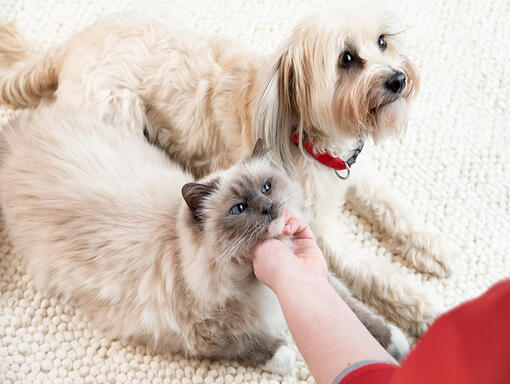
More articles by Purina One








